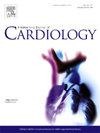Endothelial dysfunction assessed by the endothelial activation and stress index (EASIX) predicts risk of mortality in chronic heart failure patients
IF 3.2
2区 医学
Q2 CARDIAC & CARDIOVASCULAR SYSTEMS
引用次数: 0
Abstract
Background
Endothelial dysfunction accompanies chronic heart failure (CHF) but is hard to quantify in routine practice. The Endothelial Activation and Stress Index (EASIX), calculated from creatinine, lactate dehydrogenase, and platelets, predicts mortality and complications in conditions like allogeneic stem cell transplantation, COVID-19, and coronary artery disease.
Aim
To evaluate if EASIX is a prognostic biomarker in patients with CHF.
Methods
Training (n = 1796) and validation cohorts (n = 1796) included all patients from the outpatients' CHF registry of the University of Heidelberg, Germany, with available laboratory parameters for EASIX calculations at first clinical presentation. Five-year overall survival was assessed by multivariable Cox regression adjusting for age, sex, New York Heart Association (NYHA) score, etiology of heart failure, heart failure category, and NT- proBNP as covariates. Fractional polynomials modeled non-linear relationships, and prognostic performance was evaluated using the Brier score and concordance index.
Results
EASIX moderately correlated with NT- proBNP, NYHA stage and left ventricular ejection fraction (LVEF), and associated with increased hazard of death in both cohorts (hazard ratio (HR) per log2 increase: training 1.51 (1.14–2.01), p < 0.01; validation 1.59 (1.25–2.01, p < 0.001). The effect was consistent across all etiologies, classes and stages of heart failure as assessed by fractional polynomials. Pre-established EASIX cut-offs independently predicted increased risk of mortality (cut-off 2.32: training: HR 2.14 (1.52–3.02), p < 0.001; validation: HR 3.34 (1.88–5.93), p < 0.0001). Both models (continuous and discrete EASIX values) were validated in the validation cohort using integrated Brier score and C-index.
Conclusions
EASIX is a novel biomarker to predict risk of mortality in patients with CHF.
通过内皮激活和应激指数(EASIX)评估的内皮功能障碍可预测慢性心力衰竭患者的死亡风险。
背景:慢性心力衰竭(CHF)伴有内皮功能障碍,但在常规实践中难以量化。内皮活化和应激指数(EASIX)由肌酐、乳酸脱氢酶和血小板计算得出,可预测异体干细胞移植、COVID-19和冠状动脉疾病等疾病的死亡率和并发症。目的评价EASIX是否为慢性心力衰竭患者的预后生物标志物。方法:培训组(n = 1796)和验证组(n = 1796)包括来自德国海德堡大学CHF门诊登记的所有患者,这些患者在首次临床表现时具有用于EASIX计算的可用实验室参数。通过多变量Cox回归评估5年总生存率,调整年龄、性别、纽约心脏协会(NYHA)评分、心力衰竭病因、心力衰竭类别和NT- proBNP作为协变量。分数多项式模拟非线性关系,并使用Brier评分和一致性指数评估预后表现。结果:EASIX与NT- proBNP、NYHA分期和左室射血分数(LVEF)中度相关,并与两个队列的死亡风险增加相关(每log2增加的风险比(HR):训练1.51 (1.14-2.01),p )结论:EASIX是预测CHF患者死亡风险的一种新型生物标志物。
本文章由计算机程序翻译,如有差异,请以英文原文为准。
求助全文
约1分钟内获得全文
求助全文
来源期刊

International journal of cardiology
医学-心血管系统
CiteScore
6.80
自引率
5.70%
发文量
758
审稿时长
44 days
期刊介绍:
The International Journal of Cardiology is devoted to cardiology in the broadest sense. Both basic research and clinical papers can be submitted. The journal serves the interest of both practicing clinicians and researchers.
In addition to original papers, we are launching a range of new manuscript types, including Consensus and Position Papers, Systematic Reviews, Meta-analyses, and Short communications. Case reports are no longer acceptable. Controversial techniques, issues on health policy and social medicine are discussed and serve as useful tools for encouraging debate.
 求助内容:
求助内容: 应助结果提醒方式:
应助结果提醒方式:


